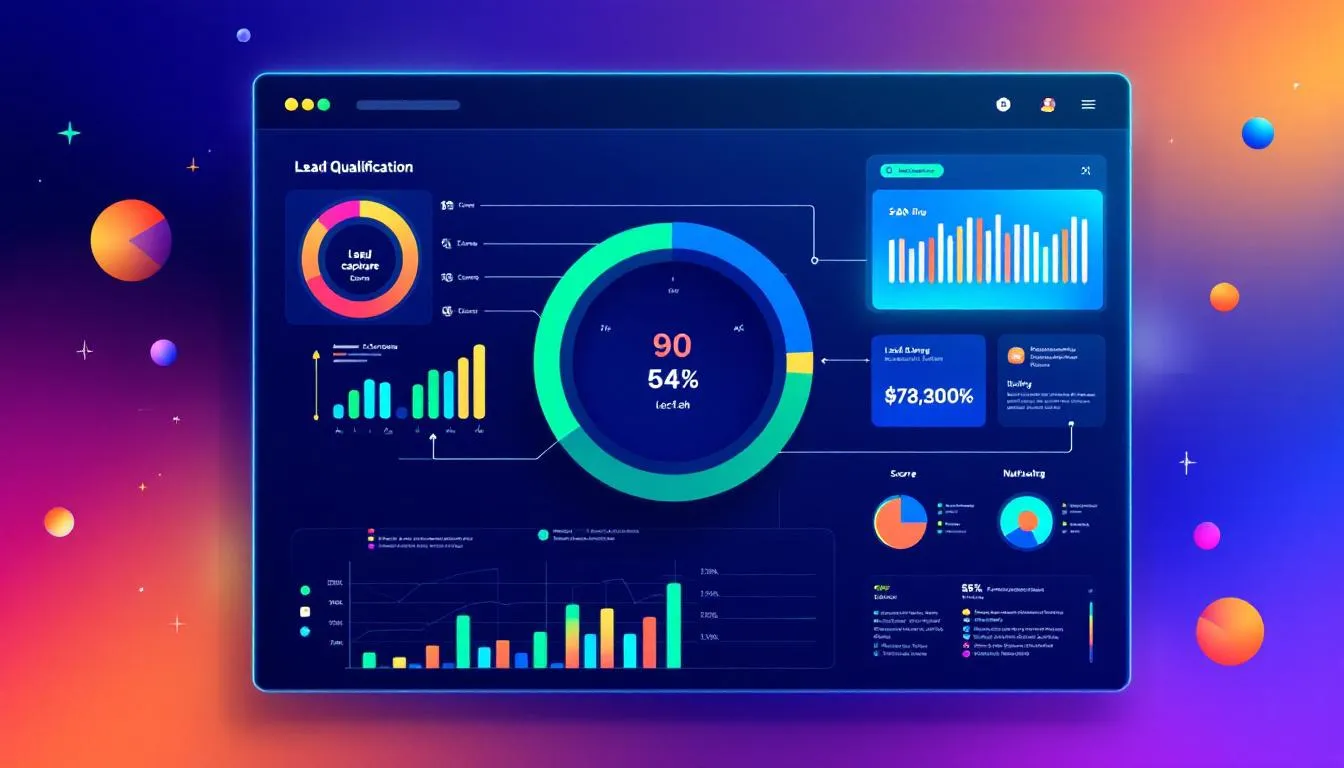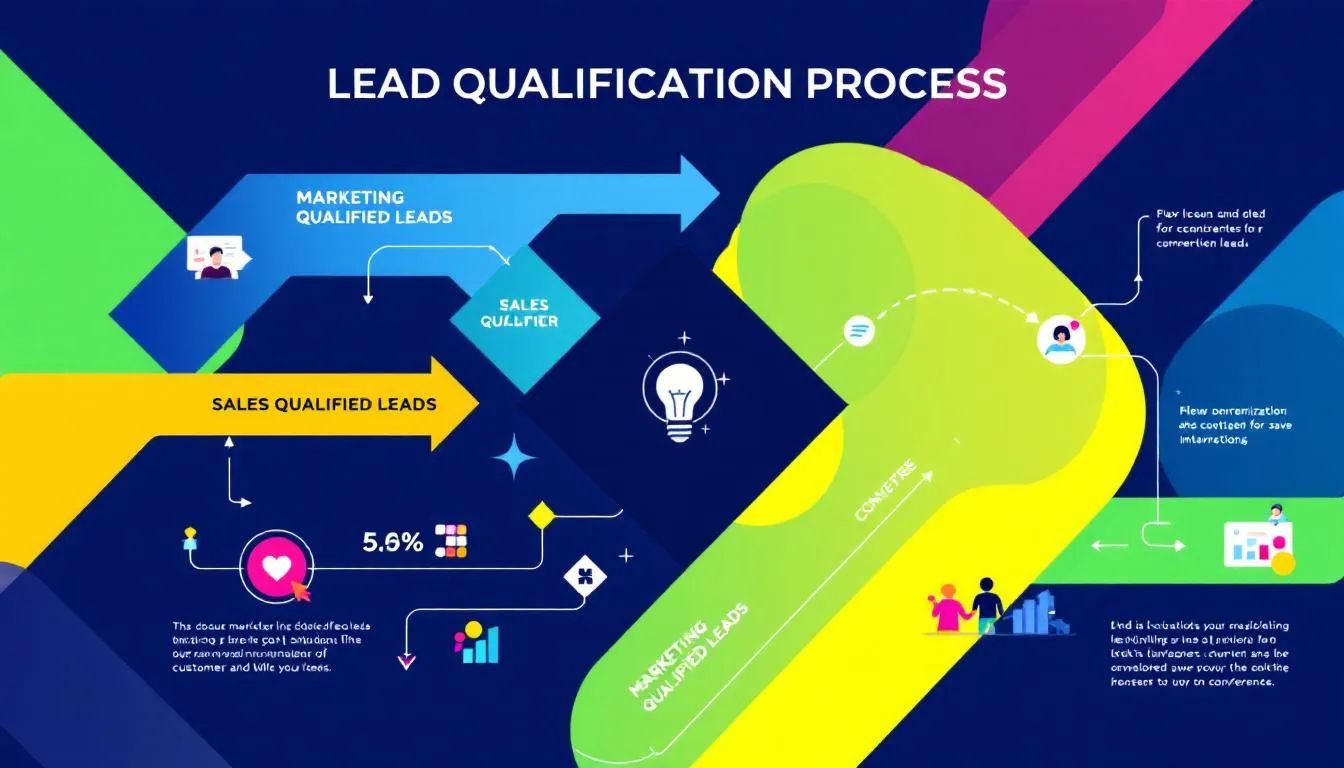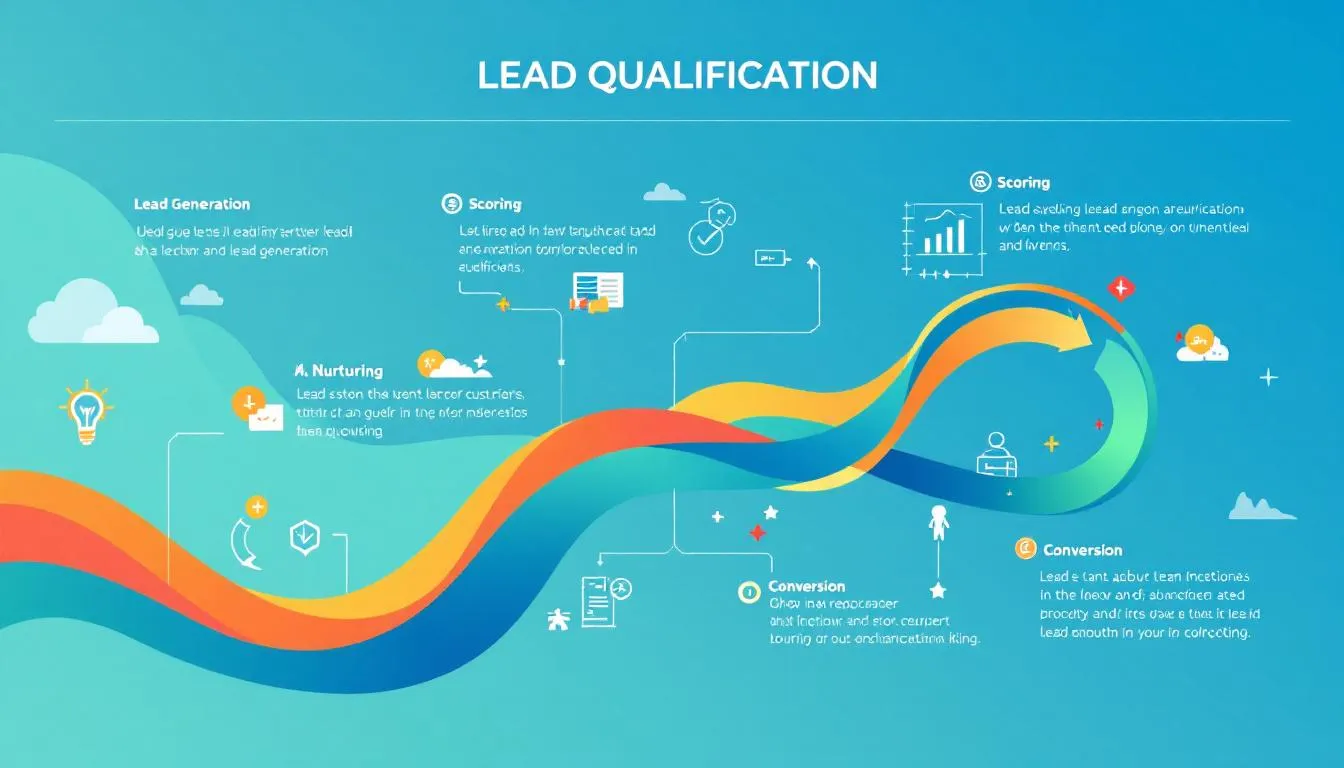Key Takeaways
- Effective lead qualification is crucial for maximizing sales efficiency by targeting leads with the right fit, authority, and budget.
- Implementing structured frameworks like BANT, CHAMP, and MEDDIC helps sales teams systematically evaluate and prioritize leads, enhancing conversion rates.
- Leveraging technology, such as AI and automation, streamlines the lead qualification process, allowing teams to focus on high-potential leads and improve overall sales productivity.
Understanding Lead Qualification

Lead qualification is the process of determining if a lead is a good fit for a product or service. It involves gathering insights to judge if a lead is likely to buy. This is not just about finding someone who is interested but someone who has the need, authority, and budget to make a purchase. Improper lead qualification can lead sales teams to overlook opportunities and waste time on unsuitable leads. Lead qualification important is essential for maximizing efficiency in the sales process.
Effective lead qualification helps improve efficiency, allowing sales teams to prioritize leads that are likely to convert. This not only boosts morale but also improves sales metrics, leading to positive implications. Identifying the best leads promptly allows sales teams to boost performance and meet quotas more efficiently.
On the flip side, moving leads down the pipeline prematurely can lead to wasted time, effort, and resources, resulting in negative consequences and a higher chance of not converting leads correctly while ensuring everyone is on the same page.
Qualified leads are characterized by their fit for the product and their ability to afford it, while unqualified leads lack one or both of these traits. Understanding the ideal customer profile is crucial for lead qualification as it helps in identifying worthwhile prospects to qualify sales leads. Sales qualification focuses on potential customers who fit the target demographic, preventing wasted time on unqualified prospects and improving overall sales success. Additionally, product qualified leads can enhance the effectiveness of this process.
The Lead Qualification Process Explained

The lead qualification process consists of assessing whether a prospect fits the ideal customer profile and evaluating their chances of converting into a customer. Typically, this process consists of four main steps:
- Defining the ideal customer profile
- Identifying leads
- Researching/evaluating leads
- Scoring the leads
Each of these steps is crucial in ensuring that only the most promising leads make it through the sales pipeline.
The first step in lead qualification involves several key actions:
- Collecting leads from various channels, which can include email, cold calls, and social media.
- During initial contact, aiming to kick-start a relationship and align needs.
- Establishing rapport and building trust with the prospect to lay the foundation for a successful sales journey.
- Researching leads before contacting them to build relationships and provide context to the discussion, focusing on lead generation.
During the discovery call, it’s essential to gather key information such as:
- The prospect’s needs
- Project timeline
- Purchasing authority
- Budgetary constraints
This information helps in evaluating the prospect’s potential for conversion and aligning their needs with your offering. After fully qualifying a lead, scheduling a follow-up with the contact to discuss the offering is crucial. Effective sales qualification reduces the time taken to confirm if you’re talking to the right person.
Ultimately, a well-structured lead qualification process ensures that sales teams focus on viable prospects, enhancing the overall efficiency of the sales funnel. Understanding the lead’s challenges and aligning your offering accordingly can greatly increase your chances of conversion.
Effective Lead Qualification Frameworks
Lead qualification frameworks provide a structured approach to qualifying leads, ensuring that no vital aspect is overlooked. These frameworks differentiate themselves from lead scoring by focusing on whether a lead is a good match for the business rather than just assigning a numerical value to their engagement. Some popular lead qualification frameworks include the lead qualification framework BANT, CHAMP, and MEDDIC.
Implementing a structured strategy for lead qualification is critical to avoid haphazard approaches that can confuse prospects. Using probing questions about challenges and innovations helps define the right leads within frameworks. Open-ended questions are considered better for qualifying leads as they elicit more information.
BANT Framework
The BANT framework originated from IBM in the 1960s and focuses on qualifying leads based on:
- Budget
- Authority
- Need
- Timing
The purpose of the BANT framework is to assess a prospect’s viability. Each component of BANT plays a crucial role in determining whether a lead is worth pursuing.
The key components and factors to assess a prospect’s viability include:
- Budget: Assess whether the prospect has the financial capacity to afford your product or service.
- Authority: Determine if you are speaking with a decision-maker who decides what solutions are required.
- Need: Consider factors like declining business performance as indicators of needs.
- Timing: Evaluate the timeline of return on investment from current solutions.
Timeline assesses when the prospect plans to make a purchase, helping prioritize leads. Because BANT is suitable for expensive products or services, it plays a crucial role in qualifying leads effectively. Ensuring that all four components are met allows sales teams to concentrate on leads with higher conversion potential, enhancing overall efficiency.
CHAMP Framework
The CHAMP framework stands for Challenges, Authority, Money, and Prioritization, providing a structured approach to lead qualification. Unlike other frameworks that start with budget, CHAMP emphasizes understanding customer challenges first, prioritizing their needs in the qualification process. This approach ensures that the solution offered aligns with the customer’s most pressing issues.
Mapping the organizational hierarchy is crucial when evaluating authority, especially if the initial contact is a low-level employee. The ‘Money’ step in the CHAMP framework inquires about the investment amount for the product or service, ensuring alignment with the customer’s budget.
Prioritization helps in determining the urgency of the prospect’s needs, guiding the sales approach accordingly.
MEDDIC Framework
The MEDDIC framework emphasizes several key elements:
- Metrics
- Economic Buyer
- Decision Criteria
- Decision Process
- Identify Pain
- Champion
Developed by Jack Napoli at PTC, this methodology is ideal for high-value, complex sales situations. Each component plays a vital role in understanding the customer’s decision-making processes and aligning the sales approach.
Key concepts include:
- Metrics: Quantifying the potential benefits of your solution.
- Economic Buyer: The person with the financial authority to make the purchase decision.
- Decision Criteria and Purchase Process: The factors and steps the customer will consider and follow in their purchase decisions.
- Identifying Pain: Understanding the customer’s pain points and how your solution addresses them.
Finally, a Champion is an internal advocate who supports your solution within the customer’s organization. The MEDDIC framework is particularly effective in complex sales situations, focusing on understanding the customer’s decision-making processes. However, it may not be suitable for businesses that sell low-cost items at high volumes.
Leveraging Technology for Lead Qualification

In today’s fast-paced sales environment, leveraging technology for lead qualification can significantly enhance efficiency and accuracy. Utilizing automation can reduce the manual effort involved in qualifying leads. Data analysis tools automate lead qualification by using algorithms to evaluate lead data for potential conversion patterns.
Chatbots and AI assistants can automate lead qualification by engaging with leads and gathering essential information in real-time. This increases efficiency by minimizing manual tasks and allowing sales teams to focus on high-priority leads. Integrating CRM systems with marketing automation tools allows for better lead management and effective qualification by syncing data.
Implementing artificial intelligence can enhance the lead scoring process by:
- Analyzing data patterns and predicting which leads are most likely to convert.
- Delivering personalized content through automated lead nurturing campaigns that guide leads through the sales process based on their behaviors.
- Using contact scoring software to score leads and indicate their value as a prospect.
The scalability of automated systems allows businesses to manage growing lead volumes without needing proportionally more resources. Automated tools streamline the lead qualification process by providing essential data and insights, reducing the workload on sales teams. As a result, businesses can focus on nurturing leads and closing deals more effectively.
The Role of Marketing Qualified Leads (MQLs)

Marketing Qualified Leads (MQLs) are identified as prospects showing a significant level of interest and engagement, making them more likely to convert into customers. These leads are characterized by their proactive engagement with brand content, such as attending webinars or downloading resources. By identifying marketing qualified lead and product qualified leads PQLs, sales teams can focus their efforts on leads that are already interested and engaged.
Creating distinct lead scores for different types of leads—like new prospects versus existing customers—allows for tailored qualification strategies. This ensures that each lead receives the appropriate level of attention and follow-up based on their engagement and interest level. Companies aligning their marketing and sales efforts achieved a 25% increase in conversion rates.
Aligning the marketing team and sales teams in the qualification process ensures that MQLs are effectively transitioned to sales-qualified leads. This collaboration enhances the overall efficiency of the sales funnel and improves conversion rates.
Transitioning from MQL to Sales Qualified Lead (SQL)
Understanding the difference between MQLs and sales qualified leads sqls is crucial for optimizing lead conversion strategies in sales. MQLs are leads that have shown interest and engagement, while SQLs are leads that have been further qualified as ready for direct sales engagement. Effective qualification of MQLs involves analyzing specific behaviors and interactions that indicate a lead’s interest level.
The process of nurturing MQLs is essential, as it helps to develop their interest until they are ready for direct sales engagement. This involves providing valuable content, addressing their pain points, and building a relationship. A structured funnel exists to guide leads from being MQLs to SQLs, ensuring tailored engagement at each stage.
By understanding the specific behaviors and interactions that signal a lead’s readiness for sales, sales teams can transition MQLs to SQLs more effectively. This ensures that only the most promising leads are pursued, enhancing overall conversion rates.
Common Mistakes in Lead Qualification
Common mistakes in lead qualification include disqualifying prospects prematurely and failing to ask detailed questions, which can hinder the identification of suitable leads. Avoiding disqualified leads often results in wasted time and resources, as teams pursue unsuitable prospects. This not only affects sales efficiency but also impacts overall morale.
Not asking detailed questions during lead qualification can lead to misunderstandings and incorrect assessments of prospects, making it difficult to nurture them effectively. Implementing a robust lead scoring system can help prioritize promising leads effectively, reducing reliance on inaccurate CRM scores.
By avoiding these common mistakes and focusing on detailed questions and robust lead scoring, sales teams can improve their lead qualification process and overall efficiency.
Best Practices for Lead Scoring
Lead scoring is the process of assigning scores to leads based on demographics, interests, and past interactions. The purpose of lead scoring is to determine which leads are most promising and prioritize efforts accordingly. Analyzing your best customers can help fine-tune your lead scoring system, ensuring that it accurately reflects the characteristics of leads most likely to convert.
A good practice is to use a scale from 1 to 10 for each criterion when qualifying leads. This helps in categorizing leads into cold lead, warm, and hot based on their engagement and readiness to purchase. Companies that utilized AI-powered lead scoring reported a significant reduction in sales cycle length, achieving up to a 30% decrease. Continuously refining your lead scoring system based on data ensures that it remains effective and relevant.
GoodSolutions.tech offers a comprehensive solution to automate this process, allowing businesses to assign points and manage their lead scoring efficiently. Leveraging technology ensures an accurate and time-efficient lead qualification process, allowing businesses to focus on high-potential leads.
Real-World Examples of Successful Lead Qualification

Sales qualification frameworks are essential for identifying leads that are likely to convert, thus improving overall sales productivity. Implementing AI-driven lead qualification solutions resulted in companies seeing an average return on investment of 500%. For instance, a B2B company saw a 40% improvement in its lead-to-opportunity ratio after using AI tools.
Sales teams that adopted AI-driven lead qualification reported a 25% increase in average deal sizes. Understanding the decision-making process of your leads and creating a compelling business case for your solution can significantly improve the chances of converting them into customers. Engaging leads with tailored messaging based on their profile and needs can help advance them through the sales funnel, especially when supported by a sales team of sales professionals.
GoodSolutions.tech has been instrumental in helping businesses achieve these results by providing innovative AI-driven solutions for lead qualification. Adopting these technologies enables companies to enhance their sales processes and achieve significant improvements in conversion rates and deal sizes.
Tips for Continuous Improvement in Lead Qualification
Ongoing evaluation and optimization are essential for refining the lead qualification process. Key actions include:
- Real-time updates to lead scoring models to respond to changes in market conditions and ensure relevance.
- Automating workflows based on lead scores to efficiently route leads to the appropriate sales representatives.
- Personalizing follow-up actions based on lead scores.
Key aspects of improving lead qualification include:
- Continuously optimizing questions, successful prospect traits, and frameworks.
- Training sales representatives on effective lead qualification techniques to improve overall efficiency.
- Implementing clear criteria to help in the swift identification of qualified leads.
Leveraging the innovative solutions by GoodSolutions.tech ensures continuous refinement and optimization of lead qualification processes. This not only enhances efficiency but also ensures that sales teams are always focusing on the most promising leads, driving overall business growth.
Summary
Mastering lead qualification is essential for any sales team aiming to improve conversion rates and overall efficiency. Understanding the fundamentals, implementing structured frameworks, and leveraging technology are key steps in this journey. By focusing on the right leads, sales teams can significantly improve their success rates and meet their quotas more effectively.
Incorporating the best practices and tools discussed in this guide, including those offered by GoodSolutions.tech, can transform your lead qualification process. This not only saves time and resources but also ensures that your sales efforts are always directed towards the most promising opportunities. Embrace these techniques and watch your sales performance soar.
Frequently Asked Questions
What does GoodSolutions.tech offer to automate business tasks?
GoodSolutions.tech provides a comprehensive solution to automate routine business tasks, enabling you to concentrate on growth and innovation. Embrace the efficiency and watch your business thrive!
How does GoodSolutions.tech’s chatbot service enhance customer support?
GoodSolutions.tech’s chatbot service significantly enhances customer support by delivering 24/7 multilingual assistance with instant, accurate responses, ensuring your customers always feel valued and heard. Embrace this technology to elevate your customer experience!
What benefit do businesses see when using chatbots according to GoodSolutions.tech?
Businesses can significantly benefit from chatbots by generating up to 40% more qualified leads. Embracing this technology can transform your engagement and drive sales!
What is a key advantage of responding to new leads quickly?
Responding to new leads quickly is crucial as it can increase your chances of closing deals by up to 21 times. Seize the moment and take action fast to maximize your success!
#LeadQualification #QualifiedLeads #SalesEfficiency #LeadScoring #BANT #CHAMP #MEDDIC #SalesAutomation #AISalesTools #CRMIntegration #SalesStrategy #MQLtoSQL #SalesFunnel #CustomerTargeting #Prospecting #SalesFrameworks #MarketingAutomation #SalesConversions #GoodSolutionsTech #Closebot
